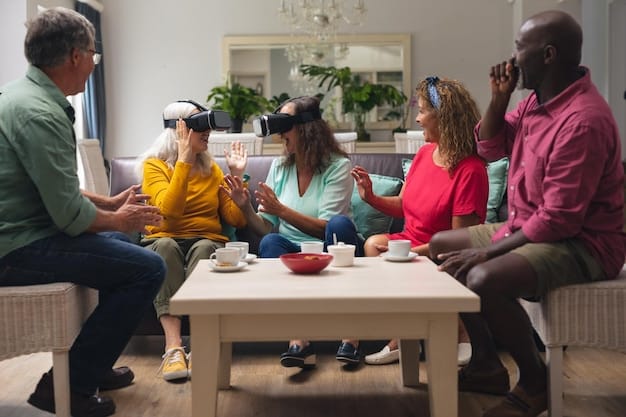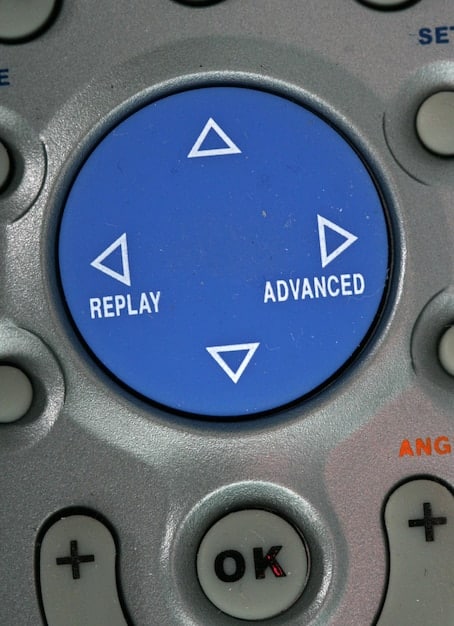Streaming Service Accessibility Features in Brazil: Entertainment for All

Streaming service accessibility features in Brazil are crucial for ensuring that individuals with disabilities can enjoy entertainment content, offering tools like subtitles, audio descriptions, and screen reader compatibility to enhance inclusivity and equal access.
In Brazil, the digital entertainment landscape is rapidly evolving, and with it comes a growing awareness of the importance of inclusivity. Streaming service accessibility features in Brazil: Ensuring entertainment for everyone, is not just a matter of compliance but a commitment to providing equal access to content for individuals with disabilities, fostering a more diverse and engaged audience.
Understanding the Landscape of Streaming Services in Brazil
The streaming market in Brazil has exploded in recent years, with international giants and local players vying for viewers’ attention. Understanding this dynamic landscape is crucial to assessing the accessibility features offered by these services and identifying gaps that need to be addressed to ensure inclusivity for all users.
From global giants like Netflix and Amazon Prime Video to local champions such as Globoplay, the variety of streaming options available to Brazilian consumers is vast. But it’s not just about the quantity of content; it’s about the quality of access for everyone.
Key Players in the Brazilian Streaming Market
Several key players dominate the Brazilian streaming market, each with varying approaches to accessibility. Understanding their strategies is essential for gauging the overall landscape of inclusivity in digital entertainment.
- Netflix: As a global leader, Netflix has invested significantly in accessibility features, including subtitles, audio descriptions, and screen reader compatibility.
- Amazon Prime Video: Amazon’s streaming service offers a wide range of content with accessibility options, but its implementation can vary depending on the title.
- Globoplay: Brazil’s largest streaming platform, Globoplay, has made strides in offering accessible content in Portuguese, catering specifically to the local market.
- Disney+: Known for family-friendly content, Disney+ is also focusing on accessibility features to reach a broader audience.

The competitive nature of Brazil’s streaming market could drive further innovation and investment in accessibility features as services strive to attract and retain a diverse audience. As awareness grows, these features may become a critical differentiator in the battle for market share and user loyalty.
Legal Framework and Accessibility Standards in Brazil
Brazil has a robust legal framework designed to protect the rights of people with disabilities. Understanding the legal requirements related to accessibility in streaming services is essential for compliance and promoting inclusivity.
Laws such as the Brazilian Inclusion Law (Lei Brasileira de Inclusão da Pessoa com Deficiência) mandate accessibility in various aspects of life, including communication and information technologies. While specific regulations for streaming services are still evolving, the general principles of accessibility apply.
Key Legal Provisions for Accessibility
Several key legal provisions and technical standards outline the requirements for accessibility in digital content. Adhering to these guidelines is vital for streaming services operating in Brazil.
- Brazilian Inclusion Law: This law establishes the rights of people with disabilities and mandates accessibility in communication, information, and services.
- ABNT NBR 15290: This technical standard provides guidelines for accessibility in websites and digital content, including streaming platforms.
- WCAG (Web Content Accessibility Guidelines): While not legally binding in Brazil, the WCAG standards are widely recognized as international best practices for web accessibility.
By adhering to these laws and standards, streaming services in Brazil can ensure that their platforms are accessible to all users, regardless of disability. This not only fulfills legal obligations but also opens up new opportunities for growth and engagement.
Common Accessibility Features in Streaming Services
Many streaming services offer a range of accessibility features designed to make content more accessible to individuals with disabilities. Understanding these features and how they function is crucial for both users and service providers.
From captions and subtitles to audio descriptions and screen reader compatibility, these features can significantly enhance the viewing experience for people with visual, auditory, or cognitive impairments. By providing options tailored to individual needs, streaming services can create a more inclusive entertainment environment.

Types of Accessibility Features
Streaming services offer a variety of accessibility features to cater to different needs.
- Subtitles and Captions: These features provide text versions of the audio, allowing individuals with hearing impairments to follow the dialogue and action.
- Audio Descriptions: Audio descriptions narrate the visual elements of the content, providing context for individuals with visual impairments.
- Screen Reader Compatibility: Screen readers enable users with visual impairments to navigate the streaming platform using text-to-speech technology.
- Adjustable Playback Speed: This feature allows users to slow down or speed up the playback speed, making it easier to follow complex content.
By offering these features, streaming services can improve the viewing experience for a diverse audience, promoting inclusivity and equal access to entertainment.
Challenges and Opportunities for Improvement
Despite advancements in accessibility features, many challenges remain in ensuring truly inclusive streaming services in Brazil. Identifying these challenges and exploring opportunities for improvement is essential for fostering a more accessible digital entertainment landscape.
From inconsistent implementation of accessibility features to a lack of awareness among content creators and users, there are numerous obstacles to overcome. However, with proactive measures and collaboration, streaming services can create more inclusive experiences.
Addressing Accessibility Gaps
Identifying and addressing gaps in accessibility is critical for improving the viewing experience for people with disabilities.
- Inconsistent Implementation: Accessibility features may vary in quality and availability across different titles, leading to a fragmented experience.
- Language Barriers: Many accessibility features are not available in Portuguese, limiting access for Brazilian users with disabilities.
- Lack of Awareness: Many content creators and users are not fully aware of the availability and benefits of accessibility features.
By taking these steps, streaming services can create a more inclusive viewing experience and reach a broader audience.
Best Practices for Implementing Accessibility Features
Implementing accessibility features effectively requires a strategic approach that considers the needs of users with disabilities throughout the content creation and distribution process. Following best practices can help streaming services optimize their efforts and ensure maximum impact.
From incorporating accessibility considerations into the design phase to providing training for content creators and staff, a holistic approach is essential for fostering a truly inclusive streaming environment.
Essential Steps for Accessibility Implementation
- Involve Users with Disabilities: Seek input from people with disabilities to understand their needs and preferences.
- Provide Training: Educate content creators and staff about accessibility best practices.
- Test and Evaluate: Conduct regular testing of accessibility features to ensure they are functioning correctly.
By following these best practices, streaming services can create more accessible and inclusive experiences for all users, fostering a more diverse and engaged audience.
The Future of Accessible Streaming in Brazil
The future of accessible streaming in Brazil looks promising, with increasing awareness, technological advancements, and regulatory pressure driving progress. As streaming services prioritize inclusivity, the viewing experience for people with disabilities will continue to improve.
From AI-powered accessibility tools to personalized user experiences, the potential for innovation is vast. By embracing these opportunities and collaborating with stakeholders, streaming services can create a more accessible and inclusive entertainment landscape for all.
| Key Aspect | Brief Description |
|---|---|
| 📺 Subtitles & Captions | Text versions of audio, aiding those with hearing impairments. |
| 🎧 Audio Descriptions | Narrates visual elements for individuals with visual impairments. |
| 🌐 Legal Framework | Brazil’s laws mandate accessibility in digital content. |
| 🤖 AI Integration | AI-driven tools enhance accessibility and personalization. |
FAQ: Streaming Service Accessibility in Brazil
▼
Accessibility ensures everyone, including those with disabilities, can enjoy content. It broadens the audience, complies with laws, and fosters inclusivity in digital entertainment. It also enhances overall user experience.
▼
Common features include subtitles, audio descriptions, screen reader compatibility, and adjustable playback speed. These tools provide access for individuals with visual, auditory, or cognitive impairments to streaming content.
▼
The Brazilian Inclusion Law mandates accessibility in communication and information technologies. While specific streaming regulations evolve, general accessibility principles apply to ensure inclusivity and equal access.
▼
Challenges include inconsistent feature implementation, language barriers (lack of Portuguese options), and limited awareness among creators and users. Addressing these gaps is crucial for a more inclusive experience.
▼
Involve users with disabilities, provide accessibility training, and regularly test features. These practices enhance the viewing experience and promote inclusivity. Also, incorporate accessibility considerations early in design.
Conclusion
The journey towards ensuring comprehensive streaming service accessibility features in Brazil: Ensuring entertainment for everyone requires continuous effort and adaptation. By understanding the legal landscape, implementing best practices, and addressing existing challenges, Brazil can lead the way in inclusive digital entertainment, fostering a more equitable and enjoyable experience for all viewers.





